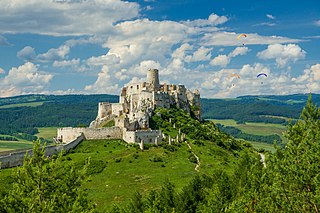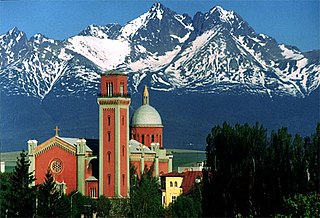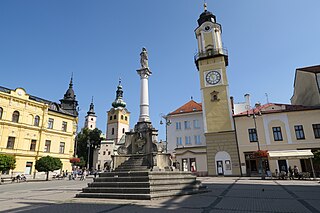
Spiš is a region in north-eastern Slovakia, with a very small area in south-eastern Poland. Spiš is an informal designation of the territory, but it is also the name of one of the 21 official tourism regions of Slovakia. The region is not an administrative division in its own right, but between the late 11th century and 1920 it was an administrative county of the Kingdom of Hungary.

Levoča is the principal town of Levoča District in the Prešov Region of eastern Slovakia, with a population of 14,256. The town has a historic center with a well-preserved town wall, a Gothic church with the tallest wooden altar in the world, carved by Master Pavol of Levoča, and many other Renaissance buildings.

Kežmarok is a town in the Spiš region of eastern Slovakia, on the Poprad River. Prior to World War I, it was in Szepes county in the Kingdom of Hungary.

The Banská Bystrica Region is one of the eight regions of Slovakia. It is the largest of the eight regions by area, and has a lower population density than any other region. The Banská Bystrica Region was established in 1923; its borders were last adjusted in 1996. Banská Bystrica consists of 514 municipalities, 24 of which have town status. Its administrative center is the eponymous town of Banská Bystrica, which is also the region's largest town. Other important towns are Zvolen and Lučenec.

Spišská Nová Ves is a town in the Košice Region of Slovakia. The town is located southeast of the High Tatras in the Spiš region, and lies on both banks of the Hornád River. It is the biggest town of the Spišská Nová Ves District.

The Oude Kerk is Amsterdam's oldest building and newest art institute. The building was founded about 1213 and consecrated in 1306 by the bishop of Utrecht with Saint Nicolas as its patron saint. After the Reformation in 1578, it became a Calvinist church, which it remains today. It stands in De Wallen, now Amsterdam's main red-light district. The square surrounding the church is the Oudekerksplein.
Tourism in Slovakia offers natural landscapes, mountains, caves, medieval castles and towns, folk architecture, spas and ski resorts.

Szepes was an administrative county of the Kingdom of Hungary, called Scepusium before the late 19th century. Its territory today lies in northeastern Slovakia, with a very small area in southeastern Poland. For the current region, see Spiš.

Červený Kláštor is a small village and municipality in the far north Kežmarok District in the Prešov Region of northern Slovakia, near the Polish border, in the Zamagurie region.

Stará Lesná or "Old Forest" is a village and municipality in Kežmarok District in the Prešov Region in north-central Slovakia. Stará Lesná is located in an area traditionally known as Spiš and it is situated within the Slovak Tourism Region of the Tatras.

Spišská Belá is a town in the Kežmarok District in the Prešov Region in Spiš in northern Slovakia. Prior to World War I, it was in Szepes county in the Kingdom of Hungary.

Hronsek is a village and municipality of the Banská Bystrica District in the Banská Bystrica Region of Slovakia.

St. Catherine's Church is the largest Protestant church in Frankfurt am Main, Germany. It is a parish church in the old city centre near one of the most famous city squares, the Hauptwache. The church is dedicated to the martyred early Christian saint Catherine of Alexandria.

The Articular church in Kežmarok is a wooden church in Kežmarok, Slovakia. The local Lutherans built it following a period of religious persecution, when in 1681 the Congress of Sopron permitted Lutherans, in articles 26 and 27 of an agreement, to erect two churches in each of eleven counties of the Kingdom of Hungary, nine of which are in present-day Slovakia. The churchers were to be made of the cheapest possible materials - this meant wood; even nails were made exclusively of wood. The construction was financially supported by Protestants from various countries, including Sweden and Denmark.

Liptov is a historical and geographical region in central Slovakia with around 140,000 inhabitants. The area is also known by the German name Liptau, the Hungarian Liptó, the Latin name Liptovium and the Polish Liptów.

Carpathian Wooden Churches is the name of a UNESCO World Heritage Site that consists of nine wooden religious buildings constructed between the 16th and 18th centuries in eight different locations in Slovakia. They include two Roman Catholic, three Protestant and three Greek Catholic churches plus one belfry in Hronsek. In addition to these churches there are about 50 more wooden churches in the territory of present-day Slovakia mainly in the northern and eastern part of the Prešov Region.

The ruins of Spiš Castle is one of the largest castle sites in Central Europe. The castle is situated above the town of Spišské Podhradie and the village of Žehra that with adjacent ecclesiastical town Spišská Kapitula form components of the UNESCO World Heritage Site. In 2009, the site was extended to include the famous altar by Master Paul of Levoča and the historic centre of Levoča with many well-preserved Renaissance buildings.

Religion in Slovakia is predominantly Christianity, adhered to by about 68.8% of the population in 2021.

St Martin's Cathedral is a cathedral in Slovakia. It is located in the town of Spišská Kapitula and is the cathedral church of the Spiš diocese.

The Evangelical Church of the Augsburg Confession in Levoča,, Slovakia, is a Lutheran church which dates from 1823 and replaced two earlier, wooden, churches.





















